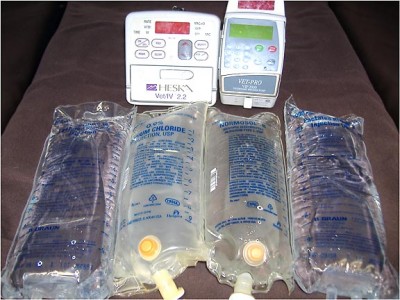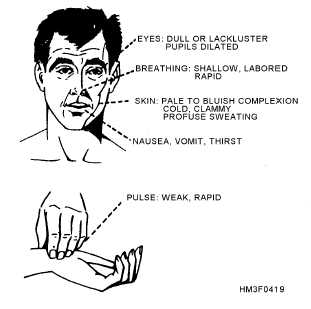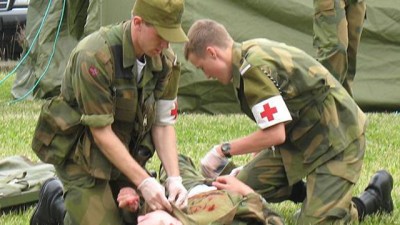
Although it may not be immediately relevant to most of us prehospital folks, the ongoing battle for supremacy in the world of IV fluids is a fascinating topic that’s worth following. We know that blood is the good stuff, but we remain interested in concocting an artificial fluid that can replace volume and mitigate the shock response — maybe even carry oxygen or support clotting — yet remain logistically feasible for everyday use. The current contenders are:
Normal Saline (aka NS)
Probably the most common fluid used today, this is nothing more than sterile water with .9% NaCL (table salt) dissolved in it. This amount of solute more or less approximates the concentration of our body’s water, which makes normal saline “isotonic”: its tonicity is approximately equal to our cells, making its osmotic pressure very low. In other words, it’s basically the same raw liquid we already have circulating, so its volume of distribution — the amount of saline that will leave the intravascular space, once we drip it in there — is relatively low.
That doesn’t mean we don’t lose a lot, though. Once it’s had a chance to settle out, quite a bit of infused saline will end up in the interstitial space. Typically this distribution will be in the ballpark of 1:3–1:4 — in other words, if we give a liter of saline, within an hour or so only about 250–300ml will remain in the intravascular space. Sicker people (who have problems like increased capillary permeability) have even higher volumes of distribution.
The benefits of normal saline: it’s very cheap. It’s very stable, lasting approximately forever on the shelf, and has minimal storage requirements. It’s compatible with every patient and every med. It’s easy to administer (any access will do, preferably large-bore).
The downsides: it carries no oxygen, impedes clotting, promotes inflammation, produces acidosis (called a hyperchloremic acidosis, since it’s secondary to the chloride content), and generally does absolutely nothing for you except increase the intravascular volume, and it does only an okay job at that.
Lactated Ringer’s (aka Ringer’s Lactate)
This stuff is basically normal saline with some extras. Like NS, it’s isotonic, so the volume of distribution is the same. But in order to mitigate the acidosis produced by NS, it’s got lactate added. Lactate converts to sodium bicarbonate in the blood, and bicarb is a strong base, so Ringer’s essentially comes “buffered” — it should have less impact on the pH. This is good, and large volumes of this stuff have a more benign effect than large volumes of saline. (Ringer’s also includes some other electrolytes, such as potassium and calcium, bringing it closer to the composition of blood serum.)
The downsides: for many prehospital services, the main “downside” is that they don’t want to stock multiple types of fluid, so once they’ve stacked NS on the shelves they’re done. Ringer’s is not as appropriate for general use, since it’s incompatible with some medications and contraindicated in some patients. There is also an old belief that it’s incompatible with blood products — that is, if you hang a bag of PRBCs on your Ringer’s line, the calcium in the Ringer’s will stimulate the coagulation cascade (PRBCs are usually stored by adding citrate, which prevents clotting by binding up calcium) and create emboli. This is now generally understood to be false.
Hypertonic solutions
Now we get into the more interesting stuff.
Remember we agreed that normal saline and Lactated Ringer’s are isotonic? What if we use a fluid that is hypertonic? This would mean that the fluid has a higher tonicity (more dissolved stuff) than our cells. Since the golden rule of osmosis is that water moves toward the space with the higher concentration of dissolved solids, adding hypertonic fluids to the blood — and hence making the blood hypertonic — will cause fluid to move from the intracellular into the intravascular space.
Why would this be good? Well, for one thing, it yields an awesome volume of distribution. Compared to the isotonics, distribution is actually reversed; we end up with more than we put in, not less. Infusing a liter of a typical hypertonic can yield an eventual volume increase of nearly 8 liters.
Isn’t it bad to suck fluid out of our cells? It would seem like it. However, for short-term use (such as emergency trauma care), the effects of this generally seem to be benign. In fact, there is some evidence that using hypertonic solutions may attenuate the inflammatory response associated with fluid administration — perhaps just because we don’t need to give as much of it.
So far, there’s insufficient evidence for the routine use of hypertonic fluids in the civilian world. So far, the research suggests that they’re “at least” as good as the isotonics. The military is another story, though; they love this stuff, because it’s light. Whether or not they should be doing that, in order for a combat medic to dump 4 liters of saline into someone, he’d have to carry 4 liters of liquid on his back — alongside absolutely everything else he’s going to need. Much better to bring some easily-portable 250ml bags of a hypertonic. It’s like an expand-o-fluid.
There are various hypertonics out there, including high-concentration salines (such as 3.0% — call it abnormal saline if you want to be cute) and others. So far nothing’s really landed on top, although mannitol is often used to suck fluid from the brain and cause “shrinkage” during cerebral edema.
Colloids
Saline is a crystalloid fluid because it’s water with small ions dissolved in it. The sodium (Na) and the chloride (Cl) are not like particles of sand, swirling around in there but too small to see — they’re fully dissolved and dissociated.
Colloids are different. A colloid is a large molecule, something too big to easily cross cellular membranes. These don’t dissolve in the same way; they’re more like ice cubes rattling around in your glass. Blood itself is a colloid, since it contains big molecules like red blood cells.
“If blood is colloidal,” the wags say, “why not try giving colloidal fluids?” Well, all right then.
One big benefit of this would be the volume of distribution. Since the colloidal solids can’t easily escape across the membranes, they remain in the intravascular space and hence keep the oncotic pressure high.
But they’re usually expensive. And tend to be more complicated (in indications and contraindications) than crystalloids. And can be more finicky to store. And for the most part, have been shown to be no better than crystalloids. Oh well.
Artificial oxygen-carrying colloids
Well, here’s a neat idea. Maybe an arbitrary colloid isn’t much good, but can we make one that mimics blood — can we come up with a fluid that actually binds and carries oxygen in the same sort of way as our red blood cells? If we could create such a thing, and if it were broadly compatible and not too expensive and had a reasonable shelf-life, it would be the next best thing to using blood and a major breakthrough.
We have created such things, either wholly artificial or derived from purified (usually cadaverous) blood samples. You can store them for ages, although they’re not particularly cheap, being new, on-patent drugs. So far they all seem to have little to no benefit in outcome — and often an increased rate of complications like heart attacks. Hmm. The search continues. (The trick may be to come up with something that shares more of blood’s qualities, such as positive-feedback binding, and maybe even some clotting goodness. We’ll see.)
Hypotonic fluids
Like half-normal saline! Good stuff, right? Wait, no. That would have a god-awful volume of distribution. Excellent, you’re paying attention.
Blood Products
You really were paying attention! Full circle we come. Although blood is not all things to everybody, and has its own negatives and caveats, at the present date if you lose blood the best replacement is blood. Of some kind.
Of what kind remains a bit of a mystery. Men in white coats continue to play with different mixtures of red cells, and plasma, and platelets, and even various concentrates and precipitates of specific clotting factors. One of the latest miracle additions is tranexamic acid, which antagonizes natural thrombolytics (remember plasmin?) and seems to reduce bleeding. There are also cool devices, used mainly during surgery, that “salvage” your own lost blood, rinse it off, and give it right back to you, which obviously simplifies some things.
Of note is an approach to transfusion developed by the anaesthesiologists at Shock Trauma in Baltimore. They like to give PRBCs and plasma until you reach a reasonably permissive pressure. Then they bolus some opiate goodness (fentanyl is nicely controllable). This puts a brake in the patient’s compensatory catecholamine response — their clamped-down veins and arteries relax a little. Which drops the pressure again. So they give some more fluid. Which raises the pressure again. Then they give more fentanyl. Repeat repeat repeat. The end result? A well-resuscitated patient — with a nice pressure — but with a relaxed, normal vasculature — and a normal volume. It’s not hard to fill up a severely compensating patient; their pipes are tiny. But it’s also not as good as filling them up to a normal perfusing volume. Neat idea. (Plus, pain management or sedation for surgery is no problem with that much fentanyl on board!)
Best of all, of course, is simply not to lose the blood to begin with. Tourniquets have really made a resurgence, and many feel that at this date, nobody with reasonably timely medical care should ever die from an extremity injury — not if you can slap a tourniquet somewhere proximal and cinch it down until the bleeding stops. The military has led the way with this, as with the use of hemostatic agents — powders you sprinkle on (or, nowadays, often come pre-embedded in a dressing) which help chemically promote clotting when combined with direct pressure.
Okay, so where does all of this leave us?
We’re not sure. Despite decades of research into this topic, best practices remain uncertain. But the following are probably true:
- Extremes are probably to be avoided. Too much or too little of anything is rarely good.
- If there is any benefit for non-oxygen-bearing, non-clotting fluids in hemorrhagic resuscitation, it is likely limited to a supplemental or temporizing role.
- Further evidence may or may not demonstrate a benefit from hypertonic solutions.
- A really usable “instead of blood” fluid remains the holy grail, and is not yet available.
and most of all…
- There are significant negatives associated with any fluid administration, so in order to produce real improvements in survival, any benefit must be substantial enough to outweigh this basic harm.
Thanks to everyone who stayed with us through this lengthy chat about shock! I want to give particular thanks to Dr. Jeffrey Guy, whose teachings were instrumental in forming the core of my own material.
Back to Part IX



Recent Comments